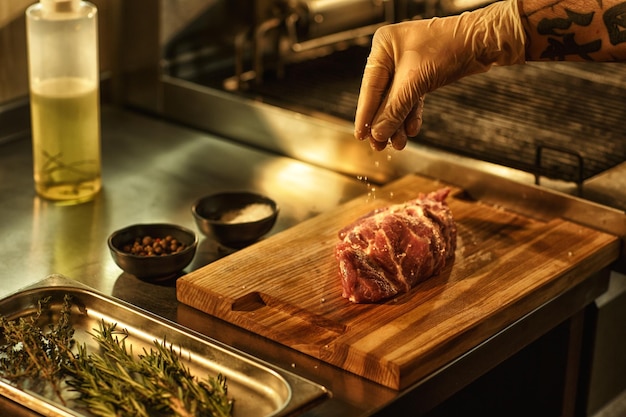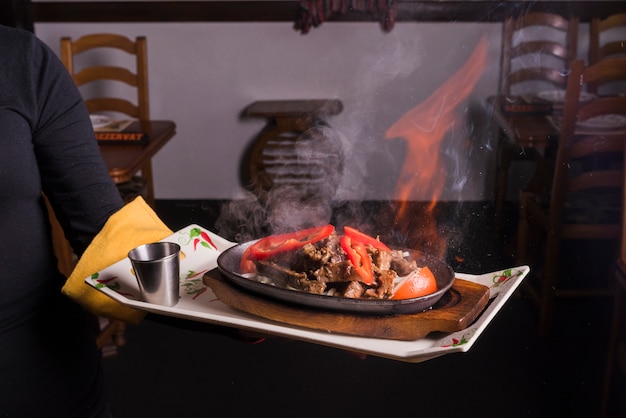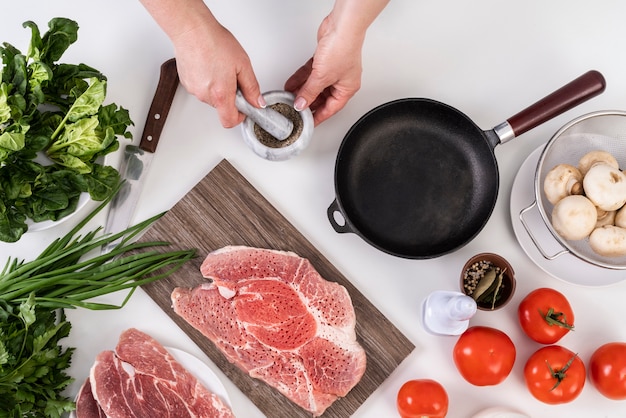Let's be honest, everyone loves a juicy, flavorful steak. But sometimes, the thought of firing up the grill or battling the oven can feel a bit daunting. That's where the humble stovetop comes in! cooking flank steak on the stovetop can be surprisingly easy and rewarding. It's a fantastic way to create a restaurant-quality meal without the fuss of fancy equipment.
Now, I've been cooking for years, and I've learned a thing or two about flank steak. It's a lean cut, which can be tricky to cook without drying it out. But, with the right technique and a little know-how, you can transform this tough, flavorful muscle into a tender and delicious centerpiece for any meal.
Get ready, because we're about to dive into the world of stovetop flank steak. We'll cover everything from choosing the perfect cut to mastering the marinade, and we'll even explore some creative side dishes and sauces. So, grab your apron, gather your ingredients, and let's get cooking!
(Part 1) Choosing the perfect flank steak

The Beefy Basics
The first step in any successful cooking adventure is choosing the right ingredients. And when it comes to flank steak, quality really matters. We're looking for a thick, juicy cut, not some thin, sad-looking piece. Aim for a flank steak that's about 1 to 1.5 inches thick. This thickness allows for a beautiful sear on the outside while keeping the inside tender and juicy.
A Trip to the Butcher
Now, I'm a big believer in supporting your local butcher. They're experts who can help you choose the best piece of meat for your needs. They'll be able to point out the most tender cuts and advise you on the right thickness for your dish. If you're headed to the supermarket, look for a flank steak that's bright red and has good marbling. Those little streaks of fat are essential for keeping the meat juicy and flavorful.
Center-Cut is the Key
Here's a little insider tip from my culinary adventures: always ask your butcher for a "center-cut" flank steak. This section of the flank is the most tender, resulting in a more flavorful and enjoyable eating experience. It's also a bit more expensive, but trust me, it's worth it for the incredible results.
(Part 2) Preparing the Flank Steak for Success

Trimming for Perfection
Once you've got your chosen flank steak, it's time to give it a little TLC. First, we'll trim any excess fat or silver skin. These bits can get tough and chewy when cooked, so it's best to remove them before you start cooking. Use a sharp knife to carefully trim the edges, leaving a nice, even surface. A little bit of fat is good for flavor, so don't go overboard with the trimming.
Tenderizing for Tenderness
Now, for the secret weapon: tenderizing! This step is crucial for transforming that tough flank steak into a tender culinary masterpiece. It's all about breaking down those muscle fibers to make the meat easier to chew. There are a couple of ways to achieve this, each with its own benefits:
- meat mallet: A meat mallet is a simple tool that you can use to pound the flank steak until it's thinner and more tender. It's a quick and effective method, but be careful not to over-pound it, or you could end up with a tough steak.
- Marinade Magic: My personal favorite is using a marinade. A good marinade not only helps tenderize the steak but also adds a ton of flavor. Think of it as a flavor bath that transforms the meat from the inside out. I always use a marinade with a bit of acidity, like lemon juice or vinegar, which helps break down the tough protein fibers.
(Part 3) Master the Marinade

A Flavor Symphony
Here's where you can unleash your creativity! You can choose a pre-made marinade from the grocery store, or you can whip up your own masterpiece. It's all about your taste buds and what flavors you love. For my flank steak marinade, I use a simple mixture of soy sauce, olive oil, garlic, ginger, and a touch of honey. It's so simple, yet it creates an explosion of flavor that's sure to satisfy.
Tips for a Winning Marinade
Here are a few tips for crafting a marinade that will take your flank steak to the next level:
- Fresh Herbs: Don't be afraid to add fresh herbs to your marinade. Herbs like rosemary, thyme, and oregano add depth, aroma, and a touch of elegance to your dish.
- Spice it Up: Experiment with different spices! Paprika, cumin, chili flakes, and even a pinch of cinnamon can add warmth and complexity to your marinade.
- Non-Reactive Container: When it comes to marinades, choosing the right container is important. Use a non-reactive container, like a glass bowl or a plastic bag, to prevent the marinade from reacting with the metal and affecting the flavor of your steak.
Marinating to Perfection
Now, let's talk about the marinating process. I recommend marinating your flank steak for at least two hours, but ideally overnight. This gives the marinade ample time to penetrate the meat and infuse it with its delicious flavors. If you're marinating overnight, keep the steak in the refrigerator to ensure it stays chilled.
(Part 4) Stovetop Cooking Secrets
The Right Pan for the Job
Okay, your flank steak is beautifully marinated, and it's time to move on to the cooking stage. First, we need the perfect pan. You want a pan that's nice and heavy-bottomed, capable of distributing heat evenly across its surface. Cast iron is a classic choice for this, but a good quality stainless steel pan will also do the trick. Make sure the pan is large enough to accommodate your flank steak comfortably.
Heat It Up!
Now, the fun part: the cooking! Get your pan really hot, crank up the heat, and don't be afraid to let it sizzle. We're aiming for a beautiful sear, and high heat is the key to achieving that delicious crust. Make sure the pan is preheated before you add the steak.
Sealing in the Juices
Carefully place your marinated flank steak into the hot pan. Let it cook undisturbed for about 3-4 minutes on each side. This crucial step is all about getting that crispy sear that locks in the juices and creates a beautiful crust. Don't touch it for at least 3 minutes, and be patient - it will release from the pan when it's ready!
(Part 5) The Flip Side
Cooking to Perfection
Once you've achieved that perfect sear on one side, flip your flank steak over to the other side and cook for another 3-4 minutes. Now, the key here is to cook the steak to your desired level of doneness. If you're after a juicy, pink center, medium-rare is the way to go, with an internal temperature of about 130-135 degrees Fahrenheit. If you prefer a bit more cooked, medium is about 140 degrees Fahrenheit.
Understanding Doneness
For those who aren't familiar with internal temperatures, here's a quick guide to understanding the different levels of doneness:
| Doneness | Internal Temperature (°F) | How to Check |
|---|---|---|
| Rare | 125-130 | Center is cool, red, and very soft |
| Medium-Rare | 130-135 | Center is warm, slightly pink, and still soft |
| Medium | 140-145 | Center is warm, mostly brown, and firm |
| Medium-Well | 150-155 | Center is warm, brown, and firm |
| Well-Done | 160 | Center is warm, brown, and very firm |
Resting for Juiciness
After cooking your flank steak to your preferred doneness, remove it from the pan and let it rest for about 10 minutes before slicing. This is a crucial step that allows the juices to redistribute throughout the meat, resulting in a much more tender and flavorful steak. Cover it loosely with foil, and let it rest peacefully on a cutting board.
(Part 6) Slicing and Serving
The Grain is Key
Now, your flank steak has rested and is ready to be sliced! This is where the grain comes into play. You want to slice the steak against the grain, which means slicing across the direction of the muscle fibers. This simple step will make your flank steak easier to chew and more tender.
Thin Slices, Big Flavor
Slice your flank steak into thin slices, about 1/4 inch thick. This ensures that each bite is juicy and flavorful. Now, your flank steak is ready to be served!
(Part 7) Side Dish Perfection
The perfect flank steak deserves a equally perfect companion. I love serving my flank steak with creamy mashed potatoes, a bright green salad, or a bed of fluffy rice. These side dishes balance the richness of the steak with refreshing flavors and textures.
(Part 8) Sauce it Up
While flank steak is incredibly delicious on its own, a sauce can really elevate the flavor profile. You can keep it simple with a pan sauce, or you can create a more complex sauce based on your culinary preferences. I like to deglaze my pan with red wine or beef broth, then add a little butter and a sprinkle of fresh herbs. It's quick, easy, and incredibly flavorful.
(Part 9) FAQs
What if my flank steak is too thin?
Don't worry! You can still make a delicious meal out of a thinner flank steak. Just cook it for a shorter amount of time, about 2-3 minutes per side, to prevent it from drying out.
Can I cook flank steak in a skillet?
Absolutely! A skillet works perfectly well. Just make sure it's heavy-bottomed and large enough to accommodate your flank steak.
How do I know if my flank steak is done?
You can use a meat thermometer to check the internal temperature, or you can use the "finger test." If the steak feels firm to the touch, it's medium-well. If it feels slightly springy, it's medium. If it feels soft, it's medium-rare.
What are some other ways to cook flank steak?
Flank steak is a versatile cut of meat. You can grill it, bake it, or even slow-cook it. Just adjust the cooking time accordingly.
What if my flank steak is tough?
Don't despair! You can always slice it thinly against the grain, and it will be much easier to chew. You can also use it in dishes where it will be broken down, like stir-fries or stews.
So there you have it, my comprehensive guide to cooking perfect flank steak on the stovetop. It's all about choosing the right cut, mastering the marinade, and getting the cooking technique right. Go on, impress your friends and family with a delicious meal that's both easy and satisfying!
Everyone is watching

How to Cook Frozen Lobster Tails Perfectly: A Step-by-Step Guide
RecipesLobster. Just the word conjures up images of lavish meals, special occasions, and a taste of luxury. But let's...

Pigs in a Blanket Cooking Time: How Long to Bake for Perfect Results
RecipesAh, pigs in a blanket. Just the name conjures up images of those delightful little parcels of crispy pastry en...

Pork Fillet Cooking Time: How Long to Cook It Perfectly
RecipesPork fillet, or tenderloin as it's sometimes called, is a real favourite in our house. It's so versatile, and...

The Ultimate Guide to Cooking Delicious Frankfurters
RecipesLet's face it, we all love a good frankfurter. It's a classic, simple, and always satisfying. But let's be rea...

Wolf Meat Recipes: A Guide to Cooking Wild Game
RecipesLet's be honest, you don't see wolf meat at your local butcher shop every day. It's a bit of a wild card, but ...
